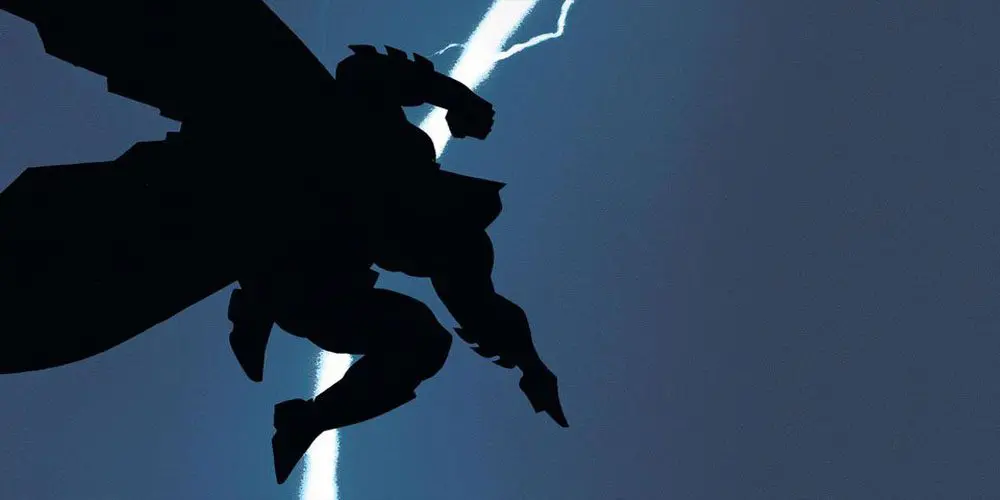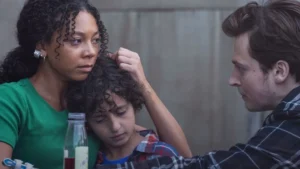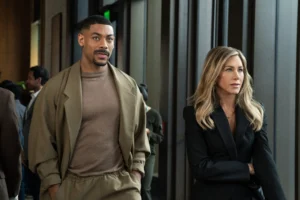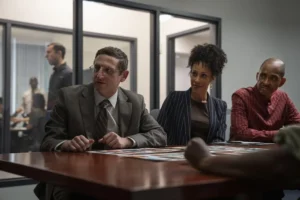Summary
The Dark Knight Returns, Part 2 provides a weaker second half that is burdened by an archaic Cold War subplot but taken together this Batman story is almost as good as it gets.
Allow me to direct you to my review of the first half of Frank Miller’s The Dark Knight Returns, which contains all the blathering about the artwork, animation, and voice acting that you could ever hope to read. All that stuff’s more or less the same in Batman: The Dark Knight Returns, Part 2, so I won’t bother reiterating the points. Much more to discuss, this time, including old Miller’s unsurprisingly simplistic view of America’s Cold War foreign policy.
But all in good time, folks. Until then, the story so far: Batman’s using his state pension to fund a return to vigilantism, despite the national government having implemented a ban on such activity. In Part 1, he wrested control of Gotham City back from a gang of studded, visor-clad street-punks known as “the Mutants”, mostly by tricking their leader into a muddy puddle and punching him repeatedly. Here, in Part 2, Miller’s story is irradiated by the fallout from Batman’s resurgence and starts to sprout new, unexpected appendages. A previously-institutionalized Joker (Michael Emerson), Gotham’s Clown Prince of Crime, has joined the media circus, using the pretense of a talk show to butcher the host and the entire studio audience; the Sons of Batman, a well-meaning unofficial fan club, have taken up arms to help clear Gotham of its criminal dregs; and in the Oval Office, a satirized Ronald Reagan despatches his pet steroidal Superman (Mark Valley) to bring Batman to justice.
Most of the movie’s disparate narrative threads are knotted together by an overarching Cold War plot that in the 80s felt topical but in 2017 feels like a chest-puffing propaganda piece. America and the Soviet Union are squabbling over the sovereignty of a made-up South American island, and through a series of extraordinarily bizarre circumstances, this petty disagreement manages to incorporate the Joker’s scheme, a nuclear launch, and a civil uprising in Gotham City, with time leftover for scenes of Superman battling Soviet forces in Cuba. And in case it isn’t obvious from the description alone, let me say unequivocally that I did not care for any of this.
You don’t remember me complaining about this in Part 1, because in Part 1 Cold War-era paranoia and media sensationalism was the thematic subtext for a fairly quintessential Batman story. Here, the superhero stuff feels grafted on to a political thriller, just one without any depth, nuance or subtlety – all aspects of storytelling which Frank Miller has what could charitably be described as a complete aversion to. None of it particularly works in any broader context, which is a shame, because the backbone of Miller’s story works so extraordinarily well that without all the mealy-mouthed anti-Russian sentiment this would easily be the best animation in DC’s already-stellar catalog.
That backbone is essentially an answer to two age-old comic-book questions: what would a truly adult version of a Joker crime spree really look like, and who would win in a fight between Batman and Superman? The idea of DC’s most iconic stalwarts having a titanic tussle might feel a little bit used-up now after it was given the live-action treatment in one of the genre’s most egregious missteps, but it still makes for a compelling finale; especially with Miller’s artwork suggesting they’re both juiced to the gills. As for the Joker stuff, well…
I think a large part of it is Michael Emerson’s scaled-back, slightly effeminate take on the character, which reduces a lot of his more comic-y traits while retaining the basic idea of a truly evil psychopath who commits heinous acts for no better reason than it amuses him. The actual specifics of his scheme – he brainwashes Gotham’s mayor into demanding a nuclear intervention overseas – are aggressively dumb, but the symbolism of him luring an aged, tired Batman into a final encounter, one which ultimately gives him what he wants, is masterful iconic storytelling. There’s an extended sequence of Joker escaping through a fairground while indiscriminately shooting and bludgeoning passers-by that I found to be perhaps the most unsettling depiction of the character’s mania that I’ve seen in any medium.
The high points of The Dark Knight Returns, Part 2 are perhaps the highest any of these movies have managed to soar, but I imagine its focus on action and resolutions to long-running relationships mean it plays better as the second half of a two-and-a-half-hour feature rather than a work of its own. That and the aimless, archaic Cold War subplot do bring it down a notch below its character-driven predecessor, but taken together, The Dark Knight Returns brings the emotional weight and thematic significance it’s known for to DC’s Bruce Timm-shepherded animated line. It might not be the best choice for the kiddies, but for older fans of Batman, of animation, of comic-books, of storytelling, this is almost as good as it gets.




